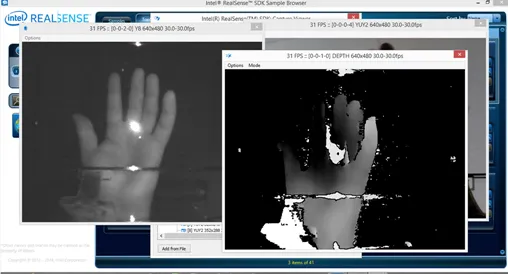December 2014 centered on migrating the Visual Touchscreens codebase from Intel’s Perceptual Computing SDK to the new RealSense 2014 platform—a technically necessary but time-consuming transition.
USB 3.0 Compatibility Challenges
The Intel RealSense 2014 camera required USB 3.0 connectivity, which should have been straightforward. Reality proved frustrating. Despite purchasing two different USB 3.0 PCIe cards for the primary desktop development machine, the RealSense camera refused to communicate through either PCIe-based USB board.
After extensive troubleshooting and failed experiments, the desktop was abandoned for RealSense development. Cost considerations ruled out purchasing an entirely new PC with native Haswell chipset support. The existing media PC with integrated USB 3.0 proved compatible, becoming the new RealSense development platform. This required setting up the entire development environment on a different machine—Visual Studio 2013 Update 4, dependencies, and tool chains all needed reinstallation.
These hardware compatibility issues consumed significant time with no technical learning value—pure troubleshooting of infrastructure rather than innovation.
API Migration Work
With hardware finally operational, the porting process began: translating existing Depth Camera Tablet code from the Intel Perceptual Computing SDK to the RealSense 2014 API. This wasn’t a simple find-and-replace operation. The new API presented numerous peculiarities and behavioral differences compared to the 2013 version.
Each functional area required careful reimplementation: depth data access, coordinate transformations, calibration procedures, and rendering pipelines all had subtly different interfaces or assumptions.
 Working around these peculiarities consumed three days of focused development. Advanced Installer was upgraded to the latest version for eventual deployment packaging.
Working around these peculiarities consumed three days of focused development. Advanced Installer was upgraded to the latest version for eventual deployment packaging.
The technical debt of platform dependencies became apparent—code tightly coupled to specific SDKs required significant rework when those platforms evolved. Yet the Intel RealSense platform represented the most promising commercially available depth camera technology, making the migration necessary despite the effort required.
Early Competition Submission
Preparing for the RealSense competition early submission deadline provided motivation for completing the port. Videos were prepared based on existing demonstration materials. Pre-entering submission information allowed meeting the deadline despite ongoing development work.
This deadline-driven development reflected a pattern: external milestones (competitions, demonstrations, meetings) created forcing functions that drove technical progress even when internal motivation waned during frustrating infrastructure battles.
Hover Touch Technology Research
With limited progress from Fogale on their hover touch technology, alternative approaches were investigated. Atmel’s evaluation boards were researched through DigiKey and direct contact with Atmel representatives. Aavamobile’s Inari tablet range was queried for hover touch capabilities.
Prototype Hardware
A new collapsible stand/prototype was commissioned from Plastic Display People to improve portability and demonstration setup. Lessons from previous prototype iterations informed design refinements for easier transport and more reliable positioning.
Curtin Ignition Follow-up
Continued interaction with Seb from the Curtin Ignition program maintained connections developed during the accelerator experience. These relationships provided ongoing access to startup community resources and perspectives beyond the pure technical development work.
The month ended with the RealSense port incomplete but progressing. The frustration of hardware compatibility issues and API migration work was real—these necessary tasks consumed time without creating new functionality or advancing innovation. Yet accessing the latest sensor technology required paying this tax of platform evolution.
The December experience reinforced an important lesson about hardware-dependent innovation: managing technical debt across changing platforms, navigating hardware compatibility issues, and maintaining development momentum through frustrating infrastructure problems all represented essential capabilities for bringing hardware innovation to market. The glamorous parts of innovation—novel algorithms, elegant interactions, compelling demonstrations—depended on unglamorous foundations of hardware compatibility, driver stability, and API mastery.